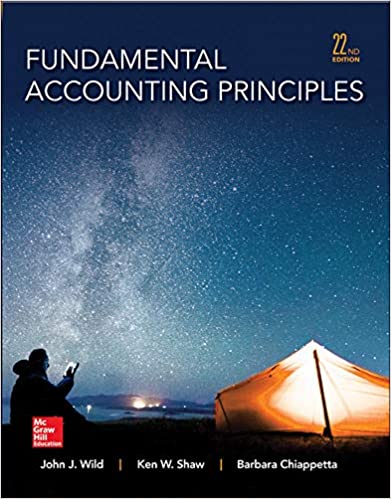
Fundamental Accounting Principles 22th Edition by John Wild ,Ken Shaw,Barbara Chiappetta
Edition 22ISBN: 978-0077862275
Fundamental Accounting Principles 22th Edition by John Wild ,Ken Shaw,Barbara Chiappetta
Edition 22ISBN: 978-0077862275 Exercise 19
Refer to the Simon Company information in Exercises 17-6 and 17-8. Compare the company's long-term risk and capital structure positions at the end of 2015 and 2014 by computing these ratios: (1) debt and equity ratios-percent rounded to one decimal, (2) debt-to-equity ratio-rounded to two decimals, and (3) times interest earned-rounded to one decimal. Comment on these ratio results.
Reference:Exercises 17-6 and 17-8
Refer to the Simon Company information in Exercise 17-6. The company's income statements for the years ended December 31, 2015 and 2014, follow. Assume that all sales are on credit and then compute: (1) days' sales uncollected, (2) accounts receivable turnover, (3) inventory turnover, and (4) days' sales in inventory. Comment on the changes in the ratios from 2014 to 2015. (Round amounts to one decimal.)

Reference: Exercise 17-6
Simon Company's year-end balance sheets follow. Express the balance sheets in common-size percents. Round amounts to the nearest one-tenth of a percent. Analyze and comment on the results.

Reference:Exercises 17-6 and 17-8
Refer to the Simon Company information in Exercise 17-6. The company's income statements for the years ended December 31, 2015 and 2014, follow. Assume that all sales are on credit and then compute: (1) days' sales uncollected, (2) accounts receivable turnover, (3) inventory turnover, and (4) days' sales in inventory. Comment on the changes in the ratios from 2014 to 2015. (Round amounts to one decimal.)

Reference: Exercise 17-6
Simon Company's year-end balance sheets follow. Express the balance sheets in common-size percents. Round amounts to the nearest one-tenth of a percent. Analyze and comment on the results.

Explanation
1.
Debt ratio (DR) is a solvency ratio m...
Fundamental Accounting Principles 22th Edition by John Wild ,Ken Shaw,Barbara Chiappetta
Why don’t you like this exercise?
Other Minimum 8 character and maximum 255 character
Character 255


